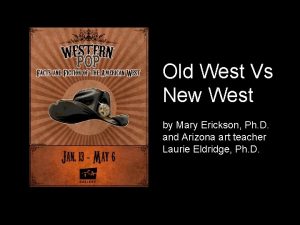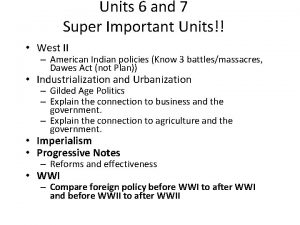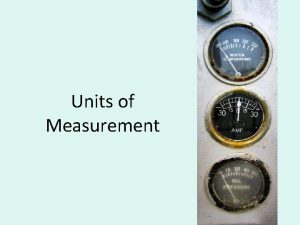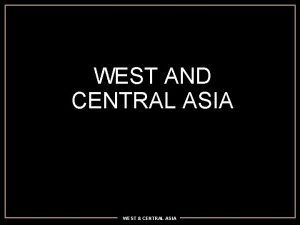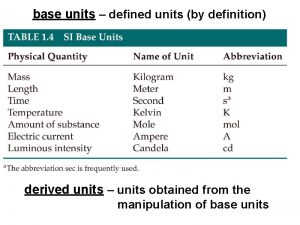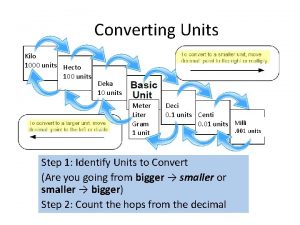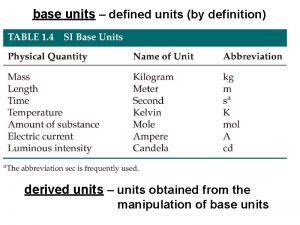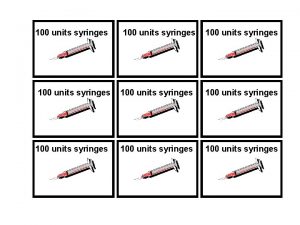Units 6 and 7 Super Important Units West



















- Slides: 19

Units 6 and 7 Super Important Units!! • West II – American Indian policies (Know 3 battles/massacres, Dawes Act (not Plan)) • Industrialization and Urbanization – Gilded Age Politics – Explain the connection to business and the government. – Explain the connection to agriculture and the government. • Imperialism • Progressive Notes – Reforms and effectiveness • WWI – Compare foreign policy before WWI to after WWI and before WWII to after WWII

Populist Party 1892 1. Govt. ownership of RRs, 2. 3. 4. 5. 6. telephone & telegraph companies. Unlimited silver coinage (inflate econ) Graduated income tax (16 th Amendment) Direct election of senators (17 th Amendment) Loans and federal warehouses for farmers (subsidies) Enacting of state law by voters thru referendum and initiatives on ballots (done during Progressive Era)

Money Question • Paper $ – Died out after 1870 s • Greenback Party failed – Idea of more $ in circulation remains. Leads to want for silver • Silver coins – Debtors, farmers, start up businesses • Borrow $ at lower interest rates • Pay off loans easily • Fought Crime of 73 (coin no silver) • WANT UNLIMITED COINAGE!! • Gold – Bankers, creditors, investors • Dollars backed by gold hold value against inflation • Compromise (bimetallism) – Bland Allison 1878 (Congress during Hayes) • Limited coinage of silver a month at 16: 1 – Sherman Silver 1890 (Harrison) • Increase amt of silver purchased by govt • Repealed 1893

LABOR UNIONS • Knights of Labor (Powderly) late 1870 s – Wanted abolition of child labor and monetary reform (RADICAL) – Black/ White; Male/ Female; but no Chinese – Opposed to striking (used boycotts and arbitration) – Got the 8 hr work day in some places – Haymarket riot destroy • American Federation of Labor (AFL) (Gompers) 1886 – Pure and simple unionism: better wages, hours and conditions. MOST SUCCESSFUL – Represent white males only; don’t want women working – Organized craft unionism – Walkouts, boycotts. Will strike if needed – Still exists today

Government and Big Business • Federal/State Govt for Business – Great Railroad (troops: executive) – Pullman (court/troops) – Other riots state troops • Federal against Business (minor) – Interstate Commerce Act (1887) after Wabash Case • Set up fed. commission to regulate railroad and railroads had to publish rates and dissolve pools • Not enforced – Sherman Anti-Trust Act (1890) • banned any formations that restrict interstate trade • Restrain corp. and unions

• Analyze the ways in which government policy and economic conditions changed American agriculture in the period 1865 – 1900. • Between 1858 and 1900, the agricultural industry experienced political changes in land management by the government that raised prices and regulated land sales and economic changes with the introduction of new technology and equipment that influenced the growth of the commercial farming business. Farmers responded to the agricultural decline caused by political and economic transformations through increased involvement in the government and in politics in order to advocate for laws and rights that benefited the agriculture community.

Politics/ Economics • • Government unwillingness to intervene in • pools and other monopolistic practices of the railroad companies Government gave best land to railroads with land grants • Homestead act provides Americans with free land which encourages agricultural development Dawes Severalty Act – Opened up reservation land for white settlement which increased the amount of acreage for farming Subsidies and land grants encouraged railroad expansion • – Cow towns emerged and hurt agriculture Timber Culture Act – 160 acres of land given to farmers who would plant trees on 40 of those acres Desert Land Act – 640 acres of land given to farmers who would begin irrigation Railroad Companies – Made farmers angry – Increased transport prices – In debt to RR companies (storage rates) Boom and Bust (panic and prosperity) – Increased land option led to decrease in debt – Farmers who couldn’t pay debt moved back east – Panic of 1893 hurt farmers, led to poverty, hardship and widespread unemployment – Dependence on international markets drove wheat prices incredibly low – US currency was backed by gold, Commercial Farming – Overproduction because farmers were trying to produce a large profit – Made farmers rely on banks – Couldn’t manage their own prices

American Looks Outward • Expansionist after 1900’s – Wanted markets overseas – Missionaries • Josiah Strong wrote Our Country encouraged superior Anglo. Saxons to spread religion and values to the “backward” people – “Yellow press” of Joseph Pulitzer and William Randolph Hearst described foreign exploits as manly adventures – Darwinism – earth belonged to the strong and fit (the U. S. ) Teddy Roosevelt would be one of these people – Competition between Japan, Germany, and Russia for colonies – Naval power increased with island bases • Alfred Mahan

During the Progressive Era (1880 -1920), women took big roles in progressive era reforms as they created many different organizations to help a wide range of people, including immigrants, the poor and African Americans. They helped change the social structure for women and by doing so, enabled them to receive major support, in government regarding to women’s rights. This ultimately led to significant political changes to the treatment and rights of women in American society. • • • POLITICS National American Women Suffrage Association (NAWSA): demanded for suffrage in “safer” and less threatening ways. 19 th amendment: gave political rights to women (voting). Alice Paul: head of National Women’s Party, argued that the 19 th amendment wouldn’t be sufficient to protect women’s rights. Equal Rights Amendment: constitutional amendment that would provide clear, legal protection for women’s rights and prohibit all discrimination on the basis of sex. Populist Party: women helped fight for farmer’s rights like Mary Lease. Suffrage Pageant: more than 5, 000 women staged a parade in Washington. 1911 State-Level Reforms: successfully created pensions for widows with dependent children. Jeanette Rankin: first female elected to the U. S house of representatives. • • • SOCIAL Women’s Women and Temperance Union: advocated abstinence from harmful substances (alcohol, drugs) of the wage system. 18 th Amendment Divorce rate increased: going from 1/20 marriages to 1/9, by 1960; women initiated the majority of them. Ida Wells Barnett: most effective women crusader; tried to discredit lynching and challenged segregation. Jane Adams’ creation of the Hull House: sought to help immigrant families adapt to the language and customs of their new countries. Birth Control General Federation of Women’s Clubs (GFWC): coordinated activities of local organizations. National Association of Colored Women: took positions on issues of particular concern to African Americans (lynching/segregation). Social Gospel Movement: often guided by women


Unit 8 Super Important Unit!!! • 1920 s – They love to compare the 20 s and 50 s • How did things change culturally in the 20 s • Was the U. S isolationist? • New Deal – How effective was it? – How much did it change the role of govt? • If I were you I would make sure I know at least 6 New Deal Policies


Foreign Policy: Isolationist? • Harding – Washington Naval Conference 1921 • Five Power Treaty- 5 largest navies agreed to ship ratio. U. S and GB not fortify territories in Pacific. Japan can. • Four Power Treaty- U. S, Japan, France, and GB respect one another’s terr. in Pacific • Nine Power Treaty- All 9 nations at conference respect Open Door Policy – Fordney Tariff – Middle East • Won oil drilling rights for U. S companies • Protecting international peace and U. S international economic interests

Foreign Policy: Isolationist? • Coolidge – Kellogg-Briand Pact (No Enforcement) • Secretary of State Kellogg and French foreign minister Briand signed pact renouncing aggressive use of national force – Dawes Plan • U. S banks lend money to Germany to rebuild economy and pay GB and France. Then, GB and France pay war debt to U. S. – U. S very dependent on Europe’s unstable economies – Mexico 1917 • Nationalized mineral and oil resources. U. S investors fear lose property. Resolved in 1927 • U. S seen as “Yankee Imperialism”

Units 9 and 10 Super Important Unit!! • Cold War – How change America in the World? – How change American Identity? • Civil Rights Movement – How did they address the problems of Reconstruction? – Success or fail? • Impact of Vietnam War – Social, Political, Economic • Events of 1960’s and 70’s impact on U. S – Economics – International – Domestic

Underdogs • Immigrants (compare and contrast experiences) – 1820 to 1860 – 1880 to 1924 – 1965 to 2000 • 1920 s vs 1950 s – Women – African Americans • Role of women – Change over time • • Before Revolutionary War, after Revolutionary War (Republican Motherhood) During Cult of Domesticity Reforms Second Great Awakening Progressivism WWI 1920 s WWII 1950 s



Added Resources • http: //www. apushexplained. com/uploads/1/3 /4/1/13418893/apush_periods_69_quickly_reviewed_slides. pdf • https: //www. youtube. com/watch? v=qi 2 y 6 JSE N 5 I&feature=youtu. be
 Superworm is super long superworm is super strong
Superworm is super long superworm is super strong East is east and west is west
East is east and west is west Wind is horizontal movement of air
Wind is horizontal movement of air What creates wind
What creates wind Noord oost zuid west ezelsbruggetje
Noord oost zuid west ezelsbruggetje Old west vs new west
Old west vs new west Example of a news story
Example of a news story From most important to least important in writing
From most important to least important in writing Least important to most important
Least important to most important Bd microfine
Bd microfine Income statement for absorption costing
Income statement for absorption costing Compare and contrast west side story and romeo and juliet
Compare and contrast west side story and romeo and juliet Lynn thier
Lynn thier Advantages of super profit method
Advantages of super profit method Super ego
Super ego Rapid and accurate image super resolution
Rapid and accurate image super resolution West yorkshire and harrogate health and care partnership
West yorkshire and harrogate health and care partnership Lines that run from north to south but measure is and west
Lines that run from north to south but measure is and west Romeo and juliet balcony scene script
Romeo and juliet balcony scene script Ramco super plaster mixing ratio
Ramco super plaster mixing ratio





